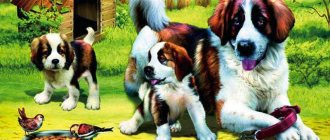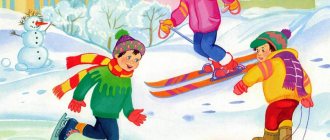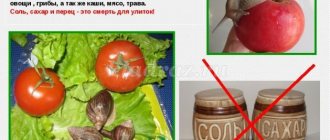Winter is the time for snow games and fun
We have all been waiting for winter for a long time, and most of all - the winter holidays, because this is a time of joy, laughter, and most importantly - real snowy fun.
You can come up with fun for every taste: making snowmen, playing snowballs, sledding, skiing or skating. You can play tag or just fool around and roll around in the snow without fear of getting dirty.
Most of all I like to play snowballs with friends and go sledding. During the holidays, we go outside together every day and immediately start playing. Someone makes a snowball first and throws it at the other. That’s when the real “battle” begins—a “snowball fight.” Then we go sledding: we find the best sledding hill not far from our yard and start going down from it. Sometimes someone may bring skis from home. Then all of us, fascinated by these “winter shoes,” take turns trying to skillfully walk at least a few steps.
On weekends my parents and I go to the skating rink. There we begin our family “marathon”: who can skate faster? Of course, dad always wins, because he is the strongest and most agile of all of us.
Winter is a wonderful time of year, which brings a lot of interesting, useful and enjoyable entertainment. In addition, my favorite holidays fall during this period - New Year and Christmas.
Winter is a time for fun snow games and fun. That's why I like it more than other seasons.
Winter fun is most often classified as children's, but in medieval Europe, where the roots of snowball fights, skating, sledding and skiing go, they were more likely to be fun for adults. And in Russia, sleigh rides and ice skating are described by Chekhov and Tolstoy as pleasures for adults.
“The sled flies like a bullet. The cut air hits you in the face, roars, whistles in your ears, tears, stings painfully from anger, wants to rip your head off your shoulders. There is no strength to breathe due to the pressure of the wind. It seems that the devil himself has grabbed us with his paws and is dragging us to hell with a roar. The surrounding objects merge into one long, rapidly running strip... Just another moment, and it seems that we will die!
This is an excerpt from Chekhov’s story “The Joke,” and few people know about Levin’s scene with Kitty at the skating rink. Something similar happened to me too, although much later than with Nadenka from Chekhov’s story, but at the moment of happiness I also wanted to ride down a high hill, which I did.

Snowball game. England
But this is still an exception, and in medieval England it was the norm. Winter there was associated primarily with snowballs, and secondarily with sledding and ice skating. Of course, the most common winter pastime is playing snowballs, but the history of its origin, unlike sledding, skating and skiing, is not described anywhere.
There is a strong suspicion, of course, unconfirmed, that playing snowballs is an invention of the inhabitants of all countries where snow falls. And, judging by the paintings of artists who loved to paint this winter fun, its distribution area includes half the world, starting with Holland, England and Russia, and ending with the Far East, Japan and China.

Sledging. England
Interestingly, few people know that snowball fighting has been an officially registered sport since 1988; the first snowball federation was created in 1993, and today annual competitions are held in which Russian athletes also take part.
Much earlier, skating, skiing and curling became sports. Ice skating spread to the northern countries in the 13th century, although skates as a device were known much earlier, for example, bone skates were invented four thousand years ago.
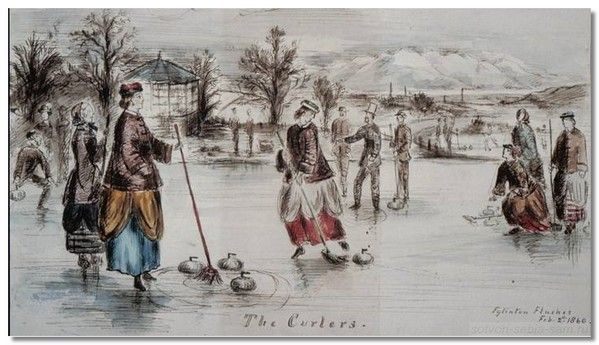
Curling
Curling, one of my most exciting and favorite games, was invented in Scotland at the beginning of the 16th century and is certainly fun for all ages and both sexes. When we talk about skates that appeared in the Netherlands and England, we must remember that we are talking about iron skates, whose name comes from the custom of decorating their front part with a horse's head.
Dutch artists loved to paint landscapes with speed skaters, and in England they loved to depict them in Books of Hours, prototypes of modern calendars. Skates came to Russia quite late, in the 18th century. They were brought by the tireless reformer Peter I, with whose light hand they began to decorate Christmas trees, celebrate New Year, Christmas and go ice skating.
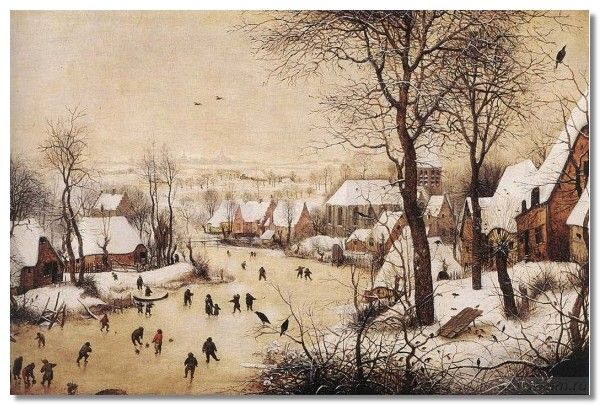
Pieter Bruegel the Elder. Landscape with skaters
Skating was especially fashionable in Pushkin’s times. When the American Jackson Geis came to Russia, who believed that it was he who first attached skates to shoes, he was amazed to learn that this was done a hundred years ago by the great Peter, who was tired of fiddling with straps and firmly attached skates to his boots. In 1838, Pauli, a gymnastics teacher, wrote:
“Of all the pleasures that the youth of the north can enjoy in winter, there is none more decent and useful than ice skating. This activity is fun for young men and enlivens adults; it develops muscular strength, agility, improves health and especially the grace of body movement. During last year's winter, the number of people skating on the Neva increased significantly, including even cadets and students from other educational institutions. This is a national Russian pleasure with a capital P.”
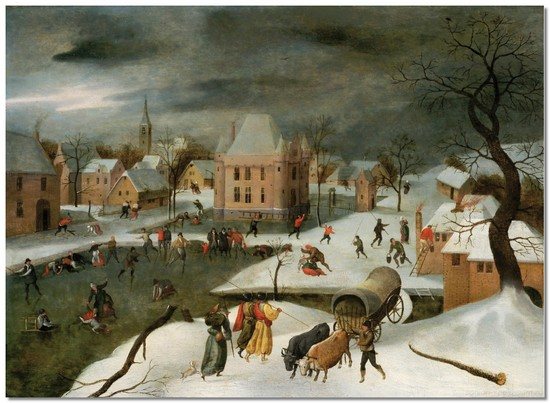
Abel Grimmer. Winter landscape
I'm not even talking about our childhood, when going to the skating rink was something akin to our older sisters' summer trips to the park and dance floors. Here is one such memory from Soviet childhood, very similar to thousands of others:
“I, like most of our boys, had “snow maidens” with rounded noses and thick runners. We tied them with belts to felt boots and rolled on the trampled snow anywhere, clinging to trucks and trams with long hooks. I didn’t cling to cars, but often to trams, until I really screwed up, tripping over a sleeper exposed by the snow, tearing my coat, which was buttoned up on the girl’s side.
I would really like to go skating at the skating rink, but on the ice we skated on “inflatables”, it was difficult to get them, and they were expensive, beyond our means. One day Tolka Mamontov, a big guy from the fourth entrance, offered me to buy blowers from him cheaply, for only 50 rubles.

The first skates, bone
True, they were defective: one skate was missing a heel. But Tolka said that it’s nothing, you can do without it, you just need to put something on it, for example, a piece of rubber sole. And for the belt, here, you see, he made two holes in the tube. I understood that they were selling me obvious rubbish, but the desire to have puffers was irresistible.
I begged my mother for money and bought skates. Only, generously, he gave them a piece of thick rubber in addition. When my mother saw the skates and tires, she clasped her hands and burst out with curses at the arrogant seller, the idiot buyer and the fool who had thrown money away. “Dumb!” - she wailed, “you can throw them in the trash right away!” In my heart I agreed with her.
I tied my skates to my felt boots at home, went down the steps, clattering, and stomped to the stadium. On the way, the belts became loose, and at the skating rink they had to be tightened again using a twist stick. After several minutes of skating, the rubber heel began to shift, the skate flew off, and I fell. The strap was fraying in holes, the sharp stump was tearing the rubber and felt boots... In general, azohunvey, as they said at home.”
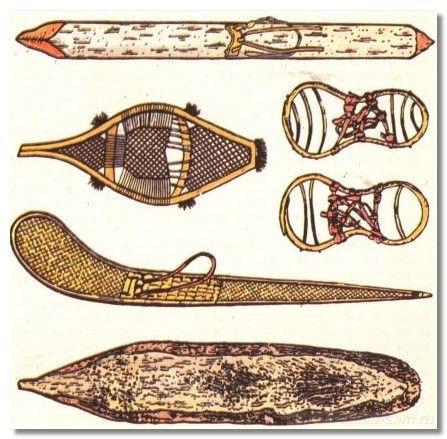
First skis
This happened in our childhood. Everything is different now. Skiing also appeared quite a long time ago. The Dane Saxo was the first to think about the shape of sliding skis, and in 1644 he created their first drawing. They were short, then their shape gradually changed until it took on its modern appearance.
At first, skis were everywhere made of wood, but since the mid-seventies of the last century, the era of plastic began. Skiing in our Soviet childhood was a topic as vast as going to the skating rink. I have already written about one such story that happened to me personally.
Well, and one more winter fun that cannot be ignored, especially in Russia. This is sleigh rides and carriage rides, beloved on all winter holidays: Christmas, New Year, Maslenitsa. Sleighs, of course, were not originally intended for fun.

Adolf-Konstantin Bumgartner-Stoilov (Russia, 1850-1924) Snowball fight
They were created to transport goods in winter, but over time, sledding turned into one of the most favorite pastimes. Young people, newlyweds and adults loved to ride with the breeze to the sound of bells, bells, accordion and songs.
On holidays, they prepared especially carefully for such winter fun: the sleigh was repaired, the horses were cleaned and decorated, and family wealth was judged by the richness of the decoration of the sleigh and the solemnity of the departure. Today, winter fun is different, but these too are preserved, even if they are just a tribute to tradition.
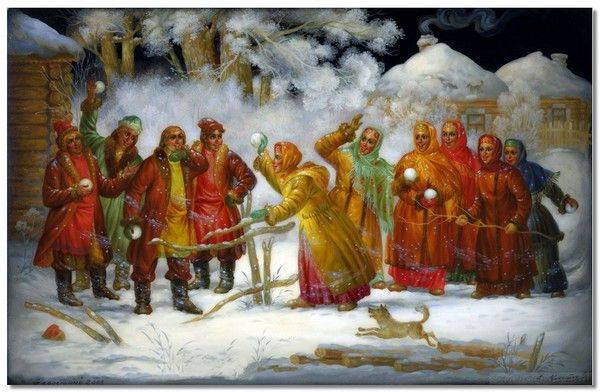
Tina Guy
Interesting? Share information!
Mini-essay on the topic “Winter fun”
A snow-white winter has arrived. Snow covered the ground with a white fluffy blanket. The time for winter fun for children has begun.
Children take sleds, skis and go up the hill. Nastenka has already completed her descent. Her friend Andrei is preparing for the start. He skillfully controls the skateboard.
It is also very interesting for skiers. The children's cheeks turned red from the frost, speed and joy. Everyone is cheerful, laughter and cheerful squeals of joy can be heard from everywhere.
This is why children love and look forward to winter.
Short story (essay-miniature) about winter fun
Frosty winter has arrived. It's time for winter fun. The skating rink on the school football field was flooded. There are always a lot of children there after school.
Misha recently bought skates. Kostya teaches him to stand on them. The girl Katya skates great. She shows the boys various complex figures.
In another part of the skating rink, the hockey team gathered. Oleg deftly sends the puck into the goal. He is the team captain and the school's best hockey player. Not far away, two boys are watching the action with interest. They are cheering for the players of the hockey team. Apparently they don't have skates themselves. Otherwise they would willingly join the team.
Children have fun and interesting. They strive to learn how to skate well. Good in winter!
Source
Essay description of the painting Winter fun
Winter has come. Winter is the most fun time of the year. How many interesting fun and games you can play together on the street! All around is white and white, soft fluffy snow shimmers in the sun and beckons you to play in the fresh frosty air.
In the painting “Winter Fun” the children are frolicking with all their might on the street, not paying attention to the cold. A clear winter day called the children into the yard. Everyone is dressed warmly, and no one is in a hurry to go home.
Each child found something to do for themselves. Someone has saddled a sled and is about to slide down the mountain with cheerful screams and laughter. A couple of guys gladly put on their skis and, creaking with snow, ride along the well-trodden track.
The lake froze and covered with ice to the delight of the children. So the skating rink is not empty, the girl is a master at skating. A group of boys and girls, meanwhile, staged a real snow battle, they roll snowballs and throw themselves at each other, trying to dodge the projectiles. The kids laugh heartily and provoke each other.
The kids also don’t waste time and make a big and funny snowman. A bucket for a hat, pebbles for eyes and a carrot for a nose. Meanwhile, the boy is rolling a new snowball and building a second snowman friend.
A girl comes from behind a hill, hurrying to join her friends in the winter fun.
The children's faces are full of delight and happiness, they are having fun and are not bored for a minute! I really want to join them. You can’t look at the picture without smiling; it infects you with a cheerful mood and a desire to play snowballs, build a snow fort or go ice skating. There is no better entertainment than playing in the yard with friends, especially in winter!
I love winter very much, it seems to me that this is a great time of year, with rich imagination and imagination you can spend it actively and usefully, without getting bored.
Other works: ← Duzelkhanov - Hunting ↑ Others Pimenov - Dispute →
Example 3
In the painting “Winter Fun” we see deep winter and children having fun. The guys are making snowmen, they have almost made two and are starting to make a third. Two boys are rolling a large snow globe, a girl is decorating a ready-made snowman, and a local dog is looking at them. In the background of the picture we see wooden houses in blue and yellow colors. The trees are covered with snow. The guys are dressed warmly: jackets, scarves, gloves and hats. The picture depicts a clear day and most likely the guys will be called to lunch, interrupting the process of making snowmen. Children make snowmen with dedication and work, and the snowmen turn out to be even bigger than themselves! Children used to spend more time outside with friends, but now they sit at home with gadgets. Children really enjoy spending this sunny, winter day in each other's company. The dog is interested in watching the guys, and I think she also wants to take part in this process. The sky is clear blue. When spring comes, their snowmen will melt. But I think the guys will find a new, exciting activity. The painting is painted in bright colors, which lifts my mood. After watching this picture I wanted to meet my friends. I really liked this painting and would like to hang it in my room.
Source: 1001sochinenie.ru
Option 2
The picture is very cute. This shows what we can do in winter. That's the name - about winter fun.
There is a lot of snow in the picture - winter. There are whole snowdrifts here - slides from which you can ride. There is also a tree covered in snow. And also a snowman. And here is a frozen lake, it’s round.
There are many children in the picture. They are all dressed warmly. In hats!
Denis, of course, skates on the lake, otherwise they would fall. There is a girl in a pink coat and a boy in green and beige. They ride beautifully. Even on one leg. Are they rehearsing a dance?
On the left, the girl puts a bucket on her head. Not for myself, of course! To the snowman... And he closed his eyes with joy.
Nearby a boy is playing in the snow. He plays not with himself, but with other guys. More precisely, with a boy wearing earflaps. The opponent's jacket is red, and this one's is blue. There is also a girl on the “battlefield”, but she is making a snowman. She rolls a big ball out of snow - she just started sculpting.
Behind them the guys are sledding. So much fun! A boy in a green jacket, felt boots and mittens raised his hands and was flying down a hill on a sled. Immediately the girl goes up the mountain, dragging her sled. She has a blue sheepskin coat and a pink hat, like the Snow Maiden.
On the right (by the tree) two children feed birds and squirrels. Directly from your hands. And the animals are not afraid of them... Also in the background (near that tree) two people are skiing. One of them has a ski (warm) suit so that he can ski comfortably. Everyone is smiling, everyone is happy about winter.
Children are not like real children. That is, they are not the same as in the photo - this is a drawing. And he is very handsome. Everything is not just white, but beautiful... The sky is bluish with pink and yellow. Snow is blue, blue, lilac and gray. All the children are in very bright clothes. The trees and bushes are black - the snow has fallen.
And there is so much you can do in winter! We must remember to try all this in winter - it’s so fun and beautiful! From such pictures you begin to love winter more - all the good things are collected here. I really like the picture, the colors, the meaning, everything about it.
Description for grades 2, 3
GCD for speech development On the topic “Winter entertainment. Storytelling from a picture."
MOSCOW DEPARTMENT OF EDUCATION
Northern Administrative District
State budget
educational institution in Moscow
"School No. 717"
Summary of direct educational activities: speech development
On the topic “Winter entertainment. Storytelling from a picture."
Kholomonova Tatyana Anatolyevna
Moscow
2017
1. Purpose of the lesson. Teach children to purposefully examine a picture (target perception, sequential examination of individual independent episodes, evaluation of what is depicted); develop the ability to write a logical, emotional and meaningful story.
2. Tasks:
Educational: - expand and enrich children’s knowledge about the features of winter nature; — stimulate creative activity; - formation of the grammatical structure of speech.
Developmental: - promote the development of coherent speech; - enrich speech with adjectives; - improve the dialogical form of speech.
Educational: - to form friendly relations between children, joint interaction; - cultivate a caring attitude towards nature.
3. Type of lesson: integrated. 4. Lesson form: group. 5. Duration: 25 min. 6. Participants: 15 people. 7. Age: 5-6 years.
8.Equipment and materials.
Set canvas, plot picture “Winter fun”, plot pictures-fragments: “Girl skating”, “Boys playing snowballs”, “Children making a snowman”, “Boy skiing”, ball, picture of a blizzard.
9. Preliminary preparation: reading literary works on the theme of the picture (poem by S. Yesenin “Winter”, I. Surikov “Winter”, “Childhood”). Learning the poem “Winter Fun”, asking riddles about the winter months. 10.Methods and techniques: - visual (looking at a picture); - verbal (sample of a teacher’s story based on a picture, leading questions, compiling a story based on fragments of a picture, voice exercise, conversation, teacher’s questions, children’s answers).
11. Lesson structure.
Looking at the painting. Comparison, coming up with a name, remembering poems by Russian poets about winter activities.
6 min.
7. Independent compilation of a story based on the painting “Winter Fun”, development of coherent speech and visual attention
The teacher offers a sample story (if the children told the story well, the sample may not be given). Children make up a story.
4 min.
8. Summary of the lesson.
The teacher evaluates the children's stories, the children express their opinions.
1 min.
12. Lesson progress
1. Organizational moment
Roof with a fur cap, White snow overhead. The yard is covered in snow, the houses are white, This is Mother - ... (Winter).
When does winter start? What winter months do you know? (December January February.)
Remember what happens only in winter? How is winter different from other seasons? (cold, frost, snow).
2. Communicate the topic and purpose. Winter is a wonderful time of year, isn't it? Children don’t want to leave home from a walk because it’s interesting outside. You can ski and skate, play hockey, build forts out of snow. Both books and paintings have been written about this time of year. Didn’t you find it strange that I said “the pictures are painted”? I was not mistaken - that’s what they say: the artist wrote (not painted) the picture.” Today we will compose a story based on the picture. And you can come up with the name of the picture yourself. (Appendix 2.).
Children guess descriptive riddles about winter:
White, cold, fluffy, creaks... (snow)
Smooth, slippery, shiny, fragile... (ice)
White, light, fluffy, carved... (snowflake)
Long, hard, slippery, shiny... (icicle)
Well done, you chose the right words.
Ball game “Which one?” Which? Which?"
Now I will throw the ball to you and ask a question, and you will catch it and give an answer to this question.
What kind of snow? - white, cold, creaky.
The wind in winter is prickly, cold and strong.
What is the air like in winter? - fresh, frosty, cold.
What kind of hill? - Icy, slippery, high.
What kind of ice? - shiny, slippery, smooth.
3. Voice exercise “Blizzard”.
This painting depicts a blizzard. What is a blizzard and how can a blizzard be called differently (blizzard, blizzard, strong wind).
Now we will play the game - Blizzard, you will sing the sound “u” either quietly or loudly, depending on whether I raise or lower my hand. The higher the hand, the louder you should sing, the lower the hand, the quieter you should sing.
4. Examination of the plot pictures - fragments for the plot picture “Winter Fun”, independent composing of sentences based on the picture fragments. (Annex 1.).
Guys, the word “riding” is repeated in all sentences. To avoid repeating the word, let's replace it with other words. (walks, drives down the mountain, slides on the ice). About which of the children can we say what is going on? (Kolya is skiing). Which of the children can be said to be going down the mountain? (The girl rides down the mountain on a sled). Which of the children can be said to be gliding on the ice? (Masha is skating on the ice) (Children select the appropriate picture
Tell us, what sentences can we make based on these four pictures? Don’t forget that children can be called differently when telling stories (children, guys, boys and girls, they).
What can you do on skates, skis; from snow?
Pictures - fragments - are displayed on the typesetting canvas. Children are given time to look freely, and then the teacher asks questions
—
Who is shown in the pictures?
- What are the children doing?
- What time of year can you play these games?
5. Exercise “Snowman” (coordination of speech with movement, development of general speech skills).
The teacher invites the children to go onto the carpet and do the exercise.
6. Conversation on the plot of the film “Winter Fun” and its fragments
.
- What time of year and what time of day is depicted in the picture?
- What was the weather like that winter day?
- How do you determine that the day is warm and sunny?
- Who is shown in the picture?
- What are the children doing?
- What winter activities are shown in the picture?
- What words can describe winter weather?
- How are the children dressed? Why?
- How do they have fun?
- Did everyone get down the mountain successfully? Why don't boys cry?
- What are the children doing at the pond?
- What mood are the children in?
- Why did you decide so?
Guys, let's look at the pictures - fragments (parts) and the picture as a whole. What is the difference? (in the fragment pictures there is only one child who performs one action, and in the large picture there are several children who perform several actions: skating, skiing, sledding.) . What is another word for entertainment? What word can be replaced? (fun). Let's come up with a name for our picture. “Winter fun”, “Good in winter”, “Winter fun”. And why ? (children sledding, skiing, skating - these are winter fun). Now …………. will read the poem “Winter Fun”. It's not boring for the kids here, We'll take our shovels with us, Build a fortress in the yard. They piled up a lot of snow, The ice house is so good, All the kids were invited here, Winter brings us happiness! Let's have fun and play, Sleds, skis and skates. We won't get bored in winter, Oh, fun days.
7. Compiling a story based on the painting “Winter Fun”
One day on a warm sunny winter day, the children went for a walk. Everyone found something to their liking. You agree with me? How can you confirm this?
The child begins to talk about children sliding down the slide.
In conclusion, I offer the children my sample story (if the children told the story well, you don’t have to give the sample): The day off has come. It was frosty winter weather outside and a lot of snow fell. Snow lay in piles on the roofs of houses and tree branches. The children dressed warmly: put on winter hats, fur coats and felt boots, took their sleds and skis and went to the hill. Although the hill was not high, many children always gathered here. The children started a fun game: they quickly rolled down the mountain and ran up. But a funny incident happened on the way down the mountain. Two boys turned over from their sleds into a snowdrift. They are having fun, laughing and shouting to their comrades to wait until the guys get up. The children on the mountain are waiting impatiently. Everyone wants to slide down the slide at full speed. The children's cheeks were flushed from the frosty air and the game. They are having fun. Winter is a wonderful time of year.
Guys, tell us about your most interesting winter entertainment. (Where was it? Who else took part? Was it fun?)
8. Summary of the lesson (evaluation of children’s work) What did you do during the lesson? What did you like most?
13. Applications.
Annex 1.
Appendix 2.
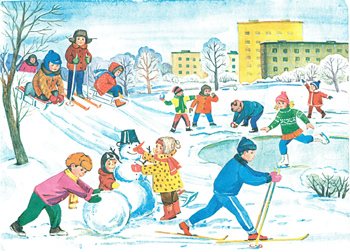
14.Literature
1. V.V.Gerbova Speech development in kindergarten: Preparatory group. – M.: MOSAIKA-SYNTHESIS, 2014. – 19-21 p.
2. Starodubova N.A. Theory and methods of speech development in preschool children.
3. Ushakova O.S., Smirnova E.A. Using a series of plot pictures in the development of coherent speech.
Pictures for children on the theme “Winter and winter fun”
Story pictures are a universal material for speech therapy work in kindergarten. They help the teacher solve the following problems:
Various pictures for children depicting winter and winter fun should definitely be among the speech therapist's teaching materials. You can use special themed sets for kindergarten or select suitable images yourself. Let's consider several options for pictures about winter that will help in your work.
The picture Winter has come opens a series of images of nature selected for the new season. It can be used in classes in senior and preparatory groups, conducting classes on the topic “Winter”, “How animals prepare for cold weather”, “Golden Autumn”, “Migratory birds”.
The plot picture Winter in the forest helps to clearly show children the changes that occur in nature, in the forest. A beautiful winter landscape helps expand a child's horizons and vocabulary.
The description of a winter forest can be played out as a journey, an imaginary adventure into a drawn area.
Snow-White Zimushchka-Winter is an ideal background for Russian folk tales; this can also be used in collective and individual work with children. A doll tetra on a transparent background superimposed on a forest landscape is suitable for this.
Stories about winter should also include a description of the New Year and Christmas holidays. Children love these Winter pictures more than others and are more willing to engage with them. It is very useful to select images of live Christmas trees in the forest and a decorated Christmas tree at a holiday, and then play “Find the Differences!”
The next picture is called Winter outside the window, it shows the life of the metropolis in the coldest time of the year. For the preparatory group, it is good to use images of snow-covered streets of a big city and winter in the countryside; a couple of these illustrations can be used for group work and games. Drawing winter in the city allows you to discuss with children not only changes in nature, but also conduct speech games and exercises on the topic of Transport and Professions, since at this time you can see new cars and people doing special work on the street.
Pictures depicting winter children's games and sports activities organized in the fresh air are an excellent opportunity not only to enrich children's active vocabulary and narrative speech, but also to work on reinforcing complex sounds. These could be exercises on differentiating between S and S, Z and Z, S and Z, S and Z.
Several pictures of winter fun will be useful for working in a group and for conducting open classes. A mnemonic table, which schematically shows:
With such support, children will be able to compose their own story not only following the example of an adult, but also with the help of independent analysis. No inscriptions are needed; even senior pupils can easily compose a complete story using clear, schematic pictures.
In speech therapy work, it is useful to use a series of story-based pictures on the topic of Winter fun, winter sports, etc. Here is an approximate list of games that a speech therapist can conduct on the topic of Winter fun using story-based pictures, one or a series:
The themes of the arrival of winter and winter children's fun are a real “methodological treasure trove” for speech therapists and teachers. There are a huge number of options for using it. We have offered you just a few of them.
Visual and didactic aid Stories from pictures Winter
Visual and didactic aid Stories from pictures Winter sports
N. Sozonova E. Kunitsina Notebook Stories about the seasons Winter
Many people love winter because it is the most beautiful time of the year, and because only in winter there is an opportunity to go sledding, skiing and skating, have a lot of snowball fights, build a fortress out of snow, and make a snow woman. On January 18, the “Winter Fun” sports festival was held at the playground of the social rehabilitation department. The main goal of the event was: to create an emotional holiday atmosphere for children, to attract children of different ages to joint play activities.
The holiday was held in the form of a relay race. Children of school and preschool age took part in the relay race. Before the start of the competition, the participants were divided into 2 equal teams. The teams were given a few minutes to come up with a name. The only condition for the team names was a theme related to snow, since the holiday was dedicated to International Snowman Day. The first team is “Snowflakes”, the second is “Snowmen”. The relay included 8 stages: “Chanters”, “Snake”, “Make a Snowman”, “Snow Debris”, “Reindeer Sleds”, “Crossing on Ice Floes”, an attraction game “Who has the least snowballs”, guessing riddles on a winter sports theme . Children took an active part in competitions: they completed tasks for dexterity and ingenuity (task “Crossing on Ice Floes”, solving riddles), competed in tasks for speed and accuracy (tasks “Reindeer Sleds”, “Snow Blocks”), supporting and helping each other to a friend. There was a cheerful and friendly atmosphere at the festival, despite the fact that there was a competitive moment during the relay race. There were no passive observers at the celebration. All the guys were very pleased.
Stories about winter for children 8-12 years old
Author's stories about winter and New Year holidays for children and teenagers
(methodological development) Myasnikova Daria Vladimirovna URFU, Associate Professor of the Department of Sociology and STU Drawing - Chingiz Uldanov
Relevance. Winter and New Year's holidays are a great time for active recreation with the whole family. Love of winter sports and winter adventures can also be conveyed through literary forms, such as short stories that can be read to children before bed. Even teenagers can be inspired to love winter sports. It is they who are offered the story “Ski Track!” Adolescence is a turning point in the consciousness of a young person. This is the time when he is looking for new heroes, new goals and values. Parental moral teachings are perceived with a slight grin. During the period of growing up, a person needs ideological support, but he is not always ready to accept it, especially from his parents. One of the tools for successful socialization is reading. Classic literature educates a teenager, but many read it “under pressure”, not wanting to get a bad grade. The situations and heroes of such works seem not modern to the children, living in a completely different time, so their thoughts and actions lose their relevance. Frankly speaking, many classic works of Russian writers do not give due place to a healthy lifestyle; more emphasis is placed on the development of the soul, self-education, the ability to devotedly love and sacrifice oneself for great goals and the Motherland. All this is great, but what is clearly missing is a new literary form - short stories about modern teenagers who love life and sports, which can be read on a mobile phone on the way to school. Goal : To involve children and teenagers in useful reading of short stories about winter fun, a healthy lifestyle, to inspire them to take real action (“tear them away” from the computer). Objectives: • Create short literary forms (stories) about children, teenagers, their actions, values; • Distribute stories on social networks that teenagers use for communication (“Vkontakte”, “My World”); • Recommend these stories to class teachers for discussion in classes and meetings of teenagers. It is advisable that they are talked about not by teachers, but by high school students invited to class hours - curators, tutors, counselors. The main idea of pedagogical development: By reading funny short stories about winter and winter fun, you can start the process of involving a child or teenager in an active life, awaken the desire to participate in competitions, achieve success in school, sports, and improve not only the soul, but also the body. Main part Three stories are offered aimed at involving children and adolescents in winter sports (“Ski track!”) and developing an active life position (“Behind the Christmas tree”, “Unexpected costume”). 1. The story “Ski!”, author Myasnikova D.V.
Ski track!
(story) Myasnikova D.V. The guys have been waiting for this competition for a long time. Not everyone can perform, or better yet win, as part of the youth team at the Russian biathlon competitions at the age of 17! Our guys were in a great mood. Tomorrow morning they need to overtake St. Petersburg and Moscow. Only lanky Lekha was more worried than anyone and kept saying things. “If only the hare didn’t jump onto the ski track.” I'll shoot you, damn it! - What kind of bunnies are there? Security everywhere, spectators. All the animals have already been scared away. – Kirill, the team captain, calmed him down, confident in the best outcome of events. “A year ago, for no apparent reason, my ski cracked on the slope, it rolled disgustingly, I didn’t get into the top three. – chatty Gray supported the conversation. - Well, they started snotting like women! – Senka barked, “Shut up, let’s go to sleep.” Kirill commanded, turning off the light. - All boys, go to sleep! There was silence. When the captain's measured snoring was heard, Gray whispered to Senka Denyukhin. - We know this hare, Grandfather, his name is Zoya Smirnova. Now you can expect everything from Lekha. When she's on the women's team, expect trouble. The guy twitches and gets nervous thinking about her. - Yes, okay, it’ll be okay! Don't talk too much, let's go to sleep! “Senka muttered, turning over to the other side. The next morning somehow didn’t work out. It's warmer. Large sticky snow fell, and even with the wind. It was slippery on the hills, and a mess in the lowlands. Every lap the guys heard the familiar voices of the girls cheering for them; the active Zoya squealed the loudest. Snow flakes blinded our eyes, sweat flowed down our temples, and only the motionless spruce trees, wrapped waist-deep in snowdrifts, envied the skiers flying somewhere. The guys walked well, clearly keeping their distance. Lekha rushed ahead, followed by Gray, then Grandfather, and the captain brought up the rear. We shot both “prone” and “standing” with dignity, and reached the last loop in the forest. Suddenly, right on the downhill slope, an amateur crossed the road for the racers, picking up decent speed on a forest track. Gray was the first to notice him and shouted with all his might. - Ski track!!! Lekha, stop! But Alexey, apparently preoccupied with thoughts of his heroic appearance in Zoya’s eyes, had no intention of slowing down. He simply did not notice the skier. Further events unfolded at the speed of a bullet flying at a target. Lech, from a low squat, drove into the skier’s head, severely scratching him with his protruding rifle. And he also did not remain in debt - he knocked out the champion’s jaw with his head. But the main thing is that both remained alive. The rest stopped successfully, jumping into the nearest snowdrifts. Security came running and an ambulance was called. Several teams flew past. Having assessed the situation, Kirill made a proposal. -Guys, let's get out of the race. Everyone was silent. Lekha, rising from the snowdrift, muttered something, adjusted his rifle, took his sticks and drove off. The team looked questioningly at the captain. Kirill answered. - OK! We're not needed here anymore, are we? Let's go! Only twice as fast! It took a long time to catch up with Lyokha, but they finally caught up. Everyone returned to their positions. He seemed to have completely lost his head, his speed was simply frantic. When the guys crossed the finish line, they realized that they had come fifth, but everyone lost sight of Lech. It turned out he went to the next round. Gray caught up with him, grabbed his hand and said. - Leshka, stop! We've arrived! - A? Fto? Uwe finif? – he said, speaking with difficulty with his jaw curled to the side. The “hero” was escorted to the emergency room by Zoya, who was inspired by the boys to help her admirer. 2. The story “Behind the Christmas tree”, author Myasnikova D
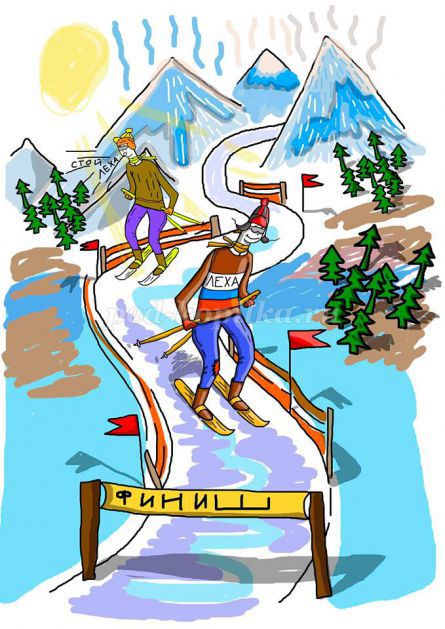
We recommend watching:
A story for children aged 7-11 about winter in the village. Essay. A walk through the winter forest A story about a New Year's holiday for children 5-8 years old
Similar articles:
Ushinsky “The pranks of the old woman-winter”
Prishvin "Birds under the snow"
Nosov “Thirty grains”
Koval "Snow Rain"
Koval "Bullfinches and cats"
Folk games for middle school students
Of course, in the middle group you can continue to offer the same games to the children, but it is better to complicate them, for example:
In addition, new exciting folk games are being introduced.
Ball rolling
This kind of fun is good to have after a snowfall. The guys are divided into teams (about 5-6 people) and distributed around the site. At the teacher’s signal, each group begins to roll a snow globe. After some time, a second signal follows, and the kids roll their big balls towards the teacher. The winner is the group with the largest lump.
Large snow globes are good for building fortresses or other structures that can also be used in games. You can also build a large snowman out of them on your site.
Children always loved to roll big balls of snow
"Bell"
An adult hangs a bell on a beautiful ribbon on a tree branch or horizontal bar. The guys throw snowballs at it to make it ring. The winner will be the one who hits the bell the maximum number of times.
Alternatively, two teams can participate in the game.
In the middle group, children can already throw snowballs at a target - for example, at a bell so that it rings
"Snowball Traps"
A circle with a diameter of about five meters is indicated in the snow. The participating children go there. The driver-trap (first time an adult, and then preschoolers) stands not far from the circle and holds a basket of snowballs in his hands. On command, he begins to throw them at the players, and they must dodge in every possible way inside the circle. After the snowballs are over, a new catcher is appointed from among the children who were not able to reach the snowballs.
The trap throws snowballs at children who must dodge them
"Snow Tower"
A small tower up to a meter long is built from snow (for this it must be loose and wet) (as an option, a snowman of similar height). The guys are divided into teams of “defenders” and “invaders”. The former block their “fortress”, defending themselves with cardboard or ice cubes), while the latter are at a distance from it, threatening them with snowballs. All together the preschoolers say:
After this, the “invaders” begin to throw snowballs at the turret (one at a time each), trying to destroy it. The “defenders” bravely repel the attack with the help of cardboard boxes and ice cubes. If the tower fails to be destroyed, the teams change roles.
Some children guard a snowman or a tower, while others try to break it with snowballs
“Ice, wind and frost” (the game came from Siberia and the Far East)
First, the guys, turning to each other, stand in pairs and clap their hands to the words of the teacher (one clap in their own palms, the other in the palms of their partner):
At the command “Wind!” “ice pieces” scatter, jump, spin, jump, etc. After the command “Frost!” Children quickly line up in a circle, forming a large ice floe - holding hands.
Holding hands in a circle, children depict a large ice floe
Source
Narrative essay “Winter fun” according to the “Planet of Knowledge” program, 2nd grade
art therapy specialist

Description of the presentation by individual slides:
An essay is a narrative based on a plot picture.
Preparatory work. What time of year is shown? Give the children names. What does each of them do? What are the guys' mood? Why do you think so?
Continue the series of words. Winter is frost, snowman... Choose the most successful title. "Winter fun" "On the hill." "Winter came". "Winter Day".
Make sentences from the words in each line. The boys started a snowball game. The boys started a snowball fight. rapidly, on, slides, boy, sledding, with, rushes. A boy quickly rushes down a hill on a sled. funny, made a snowman, baby Write the sentences correctly. The boy made a snowman out of snow. A boy made a snowman out of snow. A skier makes a track on his skis.
Essay plan - narrative. 1. Introduction. 2. Main part. 3. Conclusion. A wonderful winter day. Winter activities for children. Have fun guys!
Winter fun. It's a wonderful winter day. There was a lot of snow overnight. All the guys got dressed and ran out into the street. Vanya and Alyosha built a snow fortress and started playing snowballs. Maxim is joyfully rushing down the hill on a sled. Carefully, afraid of falling, Lena slides down behind him. Kolya confidently lays the ski track. And little Egor himself made a huge snowman! The snowman turned out to be funny: there is a carrot instead of a nose and a broom in his hand. The bunny admires the guys and is probably a little jealous of them. Have fun guys in winter!
Key words and phrases. A wonderful winter day, a snow fortress, racing on a sled, laying a track, a snowman, fun.
Material number: DB-625697
Didn't find what you were looking for?
You might be interested in these courses:
Winter fun of the Slavs
Winter time is a special state of Nature. The earth rests under snow cover, trees fall asleep, and many inhabitants of forests and fields hibernate. A sunny day is much shorter than night. All natural processes slow down. This also affects the person. His life becomes calmer, more measured. By this time, the harvest has long been in the bins, and winter worries leave much more free time. On long frosty evenings, it’s so good to gather with the whole family around the fire and listen to wise legends and fairy tales.
But this time of year is impossible to imagine without daring winter fun, which invigorates the Spirit and gets the blood going. It's time to measure your strength, dexterity, and ingenuity. For our Ancestors, all holidays, entertainment and fun were filled with deep meaning. They helped a person to tune in to natural and cosmic rhythms, to feel part of the vast World.
It is no coincidence that during the coldest and harshest time of the year, Rus' always had the most fun and exciting holidays. They burst into everyday life with bright colors and noisy, crowded entertainment. Is it possible to imagine our winter without ice slides, painted sleighs, troika rides, taking snow towns, round dances and re-dancing?
Many of the winter activities of the Slavs go back more than one millennium. It is on the territory of our country that the most ancient skis, sleighs and skates were discovered. Thus, in the Pskov region, archaeologists found skis that are 4,300 years old, and in a peat bog near Syktyvkar, the front part of a ski with a figurine of an elk, 8 thousand years old, was preserved!
The history of sleighs goes back several thousand years; the oldest bone skates are about three thousand years old. And, of course, the Slavs have preserved many games and competitions related to skates, sleds and skis.
Many winter fun of the Slavs were in one way or another connected with the military art of our Ancestors. The capture of a snowy town, fist fights, and a game called “King of the Hill” were sometimes comic in nature, and sometimes resembled real military competitions.
"King of the Hill"
- one of the most ancient winter pastimes. It consisted in the fact that one of the strongest and most experienced fighters was rising to the top of the hill. He could defend himself either with his bare hands or with an ordinary staff. The attackers were armed with whips and ropes. Their task was to climb to the top themselves, but this was not easy, because the one who was chosen as “King of the Hill” could often hold back about a dozen besiegers.
Taking the snow town
- also one of the most ancient pastimes. In a comic version, the town was defended by girls. Armed with brooms and shovels, they bravely defended the fortress, covering the attacking guys with snow and pre-prepared snow shells. The attackers were divided into foot and horsemen; it is clear that in this version the role of horses also went to the male half. If someone was knocked off his horse, he was out of the game. The attackers' task was to destroy the snow fortress and capture the banner. The one who captured the banner received the right to kiss all the defenders, but rarely anyone succeeded, since the girls defended with all their might. The siege and defense of the town was accompanied by jokes, jokes, ditties, laughter and fun.
At times this game was as close as possible to real combat. In this case, only men participated. Then the ice fortress was built according to all the rules of fortification, and real horsemen attacked it. The defenders were allowed to fire blank guns to scare the horses.
Snowball fight
could be an independent game with clearly thought out rules.
For example, if a snowball hit the right shoulder, the player was prohibited from throwing with his right hand. If it was in the leg, you had to jump on one leg. Anyone who received a snow projectile to the body was eliminated from the game.
Fist fights
- another military game of the Slavs. It was distributed throughout the country. This is a well-known rule from there - do not hit people who are lying down. The most important thing was not to hold a grudge against the enemy, to fight “with a light heart.” There were many other rules, because it had to be a fair fight, a real competition of strength, dexterity, and the ability to act together.
Title : "Taking the Town"
got another old fun. It consisted in getting a prize from a high and smooth pillar. Boots, a piece of cloth or a caftan with mittens were usually attached to the top. The task was complicated by the fact that the pillar was doused with water in the cold. Climbing on an icy surface is indeed not easy. Sometimes, instead of pillars, flexible poles were installed, which bent under the weight of the daredevil, but this did not discourage those who wanted to test their strength and dexterity.
Slideshow
and today one of the favorite winter pastimes. But if in modern times this is considered children's entertainment, then in the old days young people also loved to ride down ice slides. But we rode in all sorts of ways! Not only sleighs were used, but also matting, skins, flat “ices”, “reels”, “stubs” hollowed out of wood, reminiscent of a trough or a dugout boat. Guys often steered the boat not while sitting, but standing on their feet, steering it like a real boat, using a stick or pole. Sometimes entire sleigh trains were made from several sleds. The sleds sometimes collided, turned over, the riders rolled into the snow, that was laughter and fun!
It’s impossible to imagine our winter without riding Russian troikas
, or simply
on a horse-drawn sleigh
. The sleigh was decorated with bright cloth, felt and even velvet. A painted bow and horse harness - with multi-colored ribbons, bells, and bells. Ribbons were woven into horse manes and decorated with silk tassels. The sleighs themselves were covered with fur coats and carpets. Everyone, from young to old, including the smallest children, rode on such a sleigh. Elderly people rode separately. The youth staged real races.
Another ancient and almost forgotten game - sticks
. It is believed that she became the prototype of bandy. The players had sticks made of flexible juniper. Only the ball had to be scored not into the goal, but into the ice holes. They played “sticks” on skates, which got their name because in former times they were decorated with carved images of horse heads. The first skates were made of bone, then wooden skates appeared, and later they began to be covered with iron runners. By the way, the word runners comes from snake, snake. As, in fact, sleigh, since in ancient Slavic “sleigh” just means snake. But both the runners themselves and the trail from the sleigh really resemble a snake trail.
A game called “Kubar”
. Kubar resembles a spinning top or a top; in fact, it is a cylinder cut downwards into a cone. The expression “roll head over heels,” that is, spinning, has survived to this day. So the kubar was rotated using a rope or twig. The players' task was to launch the header across the ice so that it would spin as long as possible. Sometimes there were competitions when players, controlling the head over heels with the help of a rod, avoided obstacles; the craftsmen could make the head over heels turn over in the air. Sometimes the kubari were pitted against one another, and the one that continued to spin won.
Rarely a winter holiday was complete without skiing
. By the way, the word “ski” comes from the Slavic “sneak away”, “crawling”, this word is at least 800 years old. Ski competitions were held in high esteem by our Ancestors.
Which is not surprising, since skis have been used in winter for a long time and everywhere. Even real ski battles are known to history; starting from the 15th century, there were even special ski military formations. By the way, skis of modern sizes and shapes were discovered in Ancient Novgorod; they date back to the 13th century.
Well, what would winter be without dancing and round dances! Some Slavic dances included real fighting movements, and such as the ancient dance “Skobar” turned into a real duel at a musical signal.
The winter fun of our Ancestors not only gave vigor and health, they cultivated strength, agility, courage, ingenuity, and the ability to act together... They continued the ancient Slavic traditions, and they themselves were part of the worldview of our grandfathers and great-grandfathers, our cultural heritage, which today, more than ever must be preserved and protected.
Leave your comment
Gift certificates
Responsibility for resolving any controversial issues regarding the materials themselves and their contents is taken by the users who posted the material on the site. However, the site administration is ready to provide all possible support in resolving any issues related to the work and content of the site. If you notice that materials are being used illegally on this site, please notify the site administration using the feedback form.
All materials posted on the site were created by the authors of the site or posted by users of the site and are presented on the site for informational purposes only. Copyrights for materials belong to their legal authors. Partial or complete copying of site materials without written permission from the site administration is prohibited! The opinion of the administration may not coincide with the point of view of the authors.
Source
